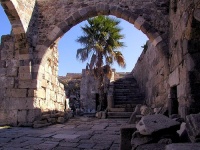Things to do in Kos
Along with sun-drenched beaches, Kos offers visitors some wonderful sightseeing opportunities. History buffs will enjoy a day trip to Patmos, the dramatically beautiful island where John the Apostle wrote the Book of Revelations. The sacred healing temple of Asclepieion is another must-see. Located south of Kos Town, it's reputedly where the the father of medicine, Hippocrates, taught his students. Agia Irini's hot sulphur springs and Agios Fokos' hot sea water pools are also worth visiting for a therapeutic dip.
Visitors should set aside some time to stroll around the old harbour area opposite Dolphins Square. The locale is home to Knights Castle, which is one of Kos Town's most famous attractions. The ruins are exciting and extensive. Visitors may also enjoy the Hellenistic Temple's ruins in the old harbour district. Ancient Greeks dedicated it to Hercules. The Archaeological Museum in the Plateia Eleftherias will captivate visitors' imaginations as well. Beach lovers should note that Kos has some of the best coasts in Greece, and the warm Aegean Sea is perfect for jet skiing, parasailing or relaxing in banana boats. Hikers will relish Dikaios Mountain.
Kos Archaeological Museum
Displaying mainly Hellenistic and Roman treasures found in and around Kos Town and dating from as far back as the 3rd century BC, the Archaeological Museum allows visitors a glimps…
Kos Archaeological Museum
Displaying mainly Hellenistic and Roman treasures found in and around Kos Town and dating from as far back as the 3rd century BC, the Archaeological Museum allows visitors a glimpse into the former glory enjoyed by this quaint port town. The museum is in Eleutherias Square and is housed in a two-storey neoclassical building that is itself a monument; it dates back to 1935 and the Italian occupation.
The museum's collection includes artefacts and archaeological findings from Kos and surrounds and even Rhodes, and there are pieces on display from sites such as ancient Asklepeion, the Altar of Dionysus, the Odeon and the Roman Residence. From original mosaics of Hippocrates, who taught here, to statues of Asklepieion, Artemis and Hygeia found north of Decumanus Maximus, a trip to the Archaeological Museum provides a good foundation of knowledge for visitors who plan to explore the surrounding sites. Many remarkable and valuable sculptures, mosaics and coins, among other things, are on display and the museum is well arranged and labelled.
Website www.greeka.com/dodecanese/kos/sightseeing/archaeological-museum/
Patmos
This island, sometimes called the 'Jerusalem of the Aegean', is an official pilgrimage site for members of the Catholic religion because it's home to the sacred cavern where the ex…
Patmos
This island, sometimes called the 'Jerusalem of the Aegean', is an official pilgrimage site for members of the Catholic religion because it's home to the sacred cavern where the exiled St John the Evangelist was inspired to write the Biblical Book of Revelations. Cruise ships and ferries keep the small port very active, disgorging visitors who wish to visit the holy cave and witness the cracks in the wall, which are said to have appeared when St John heard the voice of the Lord.
The small Monastery of the Apocalypse is very close to the cave and both are worth exploring. The small and lovely Chapel of St Anne encloses the cave and was built in the 11th century. Crowning the island is the immense Monastery of St John, with its buttressed walls and, inside, frescoes, icons, tapestries and pendants made of precious stones. The monastery was completed in the 11th century and it's a richly decorated fortress with spectacular views. The historical centre of Patmos, including the monastery and the sacred cave, is a UNESCO World Heritage Site. Visitors can walk up to the monastery from Skala along the Byzantine path.

Knights Castle
The Castle of the Knights of the Order of Saint John is situated at the entrance of Kos harbour and is an amazing place to visit. The sprawling ruins, some of which are extremely w…
Knights Castle
The Castle of the Knights of the Order of Saint John is situated at the entrance of Kos harbour and is an amazing place to visit. The sprawling ruins, some of which are extremely well-preserved, are located on what used to be an island and the bridge that once joined it to the mainland is still usable.
Parts of the castle date back to the late 14th century but, as it took over a hundred years to build, there's evidence of more than one architectural style at the site. The castle has two defensive precincts: the interior has four circular corner towers and the larger exterior precinct has massive bastions in its four corners, battlements and gun ports. The two precincts are separated by a moat and joined by a drawbridge.
There's a Hellenistic frieze over the main gate. A museum on the site, which is housed in a reconstructed building that was once the knights' warehouse, holds alters, sculptures and inscriptions from the site. The elevated sections of the castle afford visitors astounding views over the ocean. It's best to wear sensible walking shoes when visiting, as exploring the castle thoroughly means traversing some steep steps and uneven ground.
Website www.greeka.com/dodecanese/kos/sightseeing/kos-castle-knights/



